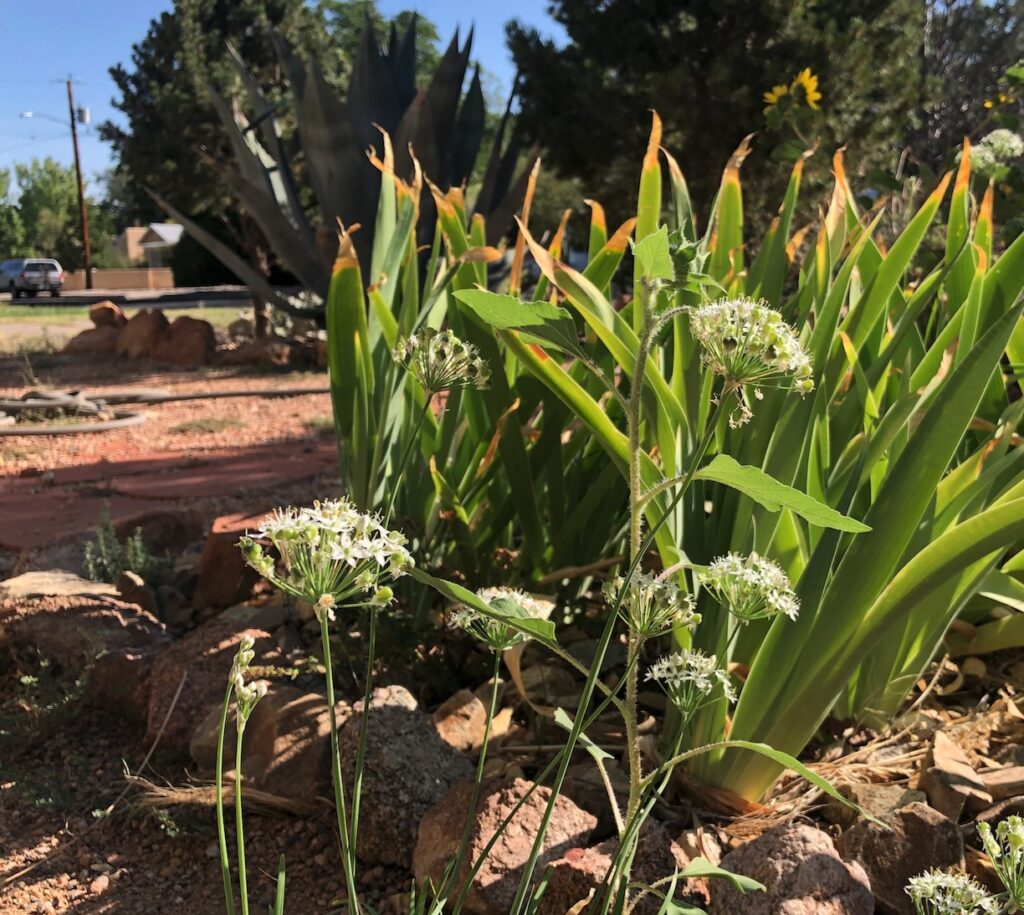
When did we plant garlic?
Sitting on our front porch the other day, Lissa and I were trying to remember when we planted the garlic. We’ve been in this house for more than three decades, and the garlic in the front yard was an early experiment. So at least a quarter century, we figure.
It’s been feral for years, along with one of the grains (barley?) that spilled out of an old bird feeder and the persistent remnants of the redbud trees we inherited from the first owner. The iris sort of fits in this category too, separated and spread out and added to over the years, built off of a single small patch that was there when we bought the house in the early 1990s.
I’ve written before in this space about the idea of garden in the new book Bob Berrens and I are writing about Albuquerque’s relationship with the Rio Grande. Here’s a bit from the book’s opening chapter, which I was working on again this morning as I work on revisions based on the editorial feedback we’ve gotten:
Throughout its history, the English word “garden” has done yeoman’s work, traveling with us as we made a modern world. At its simplest, it is a noun describing a place behind the house where we grow flowers, vegetables, and perhaps a few fruit trees. At its most expansive, it is “a region of great fertility.” Kent was “the Garden of England,” “known for its abundance of fruit and crops.” The province of Touraine was “the Garden of France.” But it is the noun’s interplay with garden’s verb form that does the word’s linguistic heavy lifting – “to bring a landscape into a particular state” – to mindfully and intentionally change the land on which we live.
It’s the verb form, at its most expansive, that Bob and I are playing with in the book – the deliberate transformation of Albuquerque’s piece of the Rio Grande Valley in a way that defines modern Albuquerque’s identity. But like our front yard with its feral garlic, the river and the valley in part are doing their own thing, in a tension between individual agency, collective agency, and the underlying reality we face in shaping our urban environment.
The Rio Grande keeps pushing back against our efforts.
It’s also a contested space (this bit of the analogy goes beyond our garlic-infested front garden), with conflict over who gets to define the gardening goal, something that underscores the power dynamics inherent in collective action as we garden the river valley floor. Lissa and I have no such tension in our garden. Lissa is the artist. I love helping her carry out her vision.
But like our front yard garlic patch, a feral sprinkling amid one of the recently added iris beds, it’s an ongoing process. A garden is never done.

John
Garden from the German “Garten” ? Your garlic flowers don’t look anything like mine that I planted from a garlic I bought at Safeway. I understand they fend off tree boring weevils if you plant them around the tree.
Your “wandering” and “wondering” puts me in mind of indigenous people who have lived in a place for centuries. Who also shaped their surroundings but in ways we don’t acknowledge or perceive. I wonder how long before the Rio Grande region will return to a natural state. But perhaps with a very different climate and fauna and flora.
That is such a lovely paragraph. I guess I will need to get a copy of the book when it comes out!
I look forward to publication of your book so I can buy copies for my family in Albuquerque!
I plant my garlic in October and often harvest the following June.